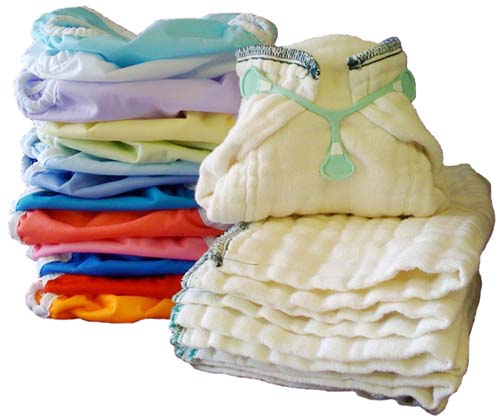Styles:
1. Prefold with Diaper Cover:

This is an old school method. You use the traditional rectangular cloth that most people use as a burp cloth now... they are called prefolds. One nice advancement is the Snappi. This is a fastener gizmo that allows you to hold the prefold on without safety pins. This is not waterproof so you need to put a cover on over it. They make covers that pull up or snap on the sides. The only advantage I see to this method is cost. It is very, very cheap. I am not hardcore enough to want to deal with these all day though. (Side note: Some people use prefolds as inserts or for extra absorbancy... I will explain later)
2. Fitted Diaper with Cover:

Prefolds are a pain to fold onto a squirmy baby. Fitted diapers solve this problem. They are shaped to fit your baby well and they snap closed. However, they are not waterproof so you still need a cover.
3. Pocket Diaper:

This is a waterproof diaper cover with a soft, thin layer of fabric on the inside... the two layers form a pocket that can be accessed through an opening at one end. You place an "insert" into the pocket for absorbancy. An insert is several layers of absorbant fabric sewn together. Pocket diapers are very common. They are nice because you can adjust the absorbancy by using different amounts/types of inserts and they are user friendly.
4. All-in-One:
This is like a pocket diaper only the inserts are sewn in. They are often sewn in on just one side to allow for easier cleaning and drying. This is the ultimate convenience diaper. They can be pricey but they are great for a cloth newcomer or someone that needs to convince a daycare or grandparent to use them. One disadvantage is you can't remove the inserts so you end up with a rather bulky diaper even if you don't need it.
5. Hybrid:

This is a waterproof diaper cover that holds an insert without needing to stuff it in a pocket. These are becoming popular because you can reuse the cover without washing it (as long as it doesn't get dirty). This is especially nice when you are on the go because you only need to pack inserts (and an extra cover just in case) in your diaper bag. You can use disposable inserts. I've tried them and I don't really understand what the point is, but some people really like them. (Side note: I would still recommend washing the covers every day or two. I use these and I usually throw the cover in the diaper pail after 3-4 changes.)
Fabrics:
1. Microfiber (MF):

These inserts consist of several layers of polyester microfiber terry cloth. They are generally the cheapest. They are much more absorbant than regular cotton but will release liquid when squished. They dry fast but have a reputation for holding on to stinky smells after awhile.
2. Bamboo:
These inserts cost more than microfiber but they are slimmer and more absorbant. One thing to keep in mind is the more absorbant the fabric, the longer the drying time. It is also advertised as having antimicrobial properties. I haven't researched this deep enough to elaborate on that.
3. Hemp:
These inserts are supposedly the most absorbant. They are also the most costly. I have never used them, but I have heard they take a very long time to dry and can become stiff as they get older. I have also heard that they take extensive prepping.
(Side note: "Prepping" is a procedure of preparing any brand-new insert for use, usually by washing multiple times and/or boiling. It is a pain, but you only have to do it once. It removes oils and residues from the fabric to make it more absorbant.)
4. Polyurethane Laminate (PUL):
Fabric that has a waterproof laminate backing. It is soft and flexible and can withstand high temperatures in a dryer. This is what most diaper covers are made of.
Other Features to Consider:
1. Snaps vs. Velcro (Aplix):


Snap closures are more durable and hold better. Velcro is much quicker and easier to fasten but it wears out, especially if you dry in the dryer on high heat. In my experience, the velcro made the fabric of the diaper lay awkward and it sometimes rubbed on my little guy's tummy.
2. One Size (OS) Diapers:
These are diapers that can be adjusted in the rise (how high they come up on your baby), allowing them to fit a weight range of about 8-35lbs (depending on the brand). This is acheived by a series of snaps in the front that allow you to fold the fabric, making it shorter. This allows you to use one set of diapers for a long time. However, most newborns will be a little too small for a OS.
3. Liners:


These are thin sheets that can be placed in a cloth diaper to catch poop. It makes clean up easier and protects your diaper from some staining. There are disposable and reusable varieties. The downside to using these is you never know when your child is going to poop so you need to put them in every diaper even though most diaper changes are only pee. I used them for a while but I felt they were too much of a hassle.
No comments:
Post a Comment